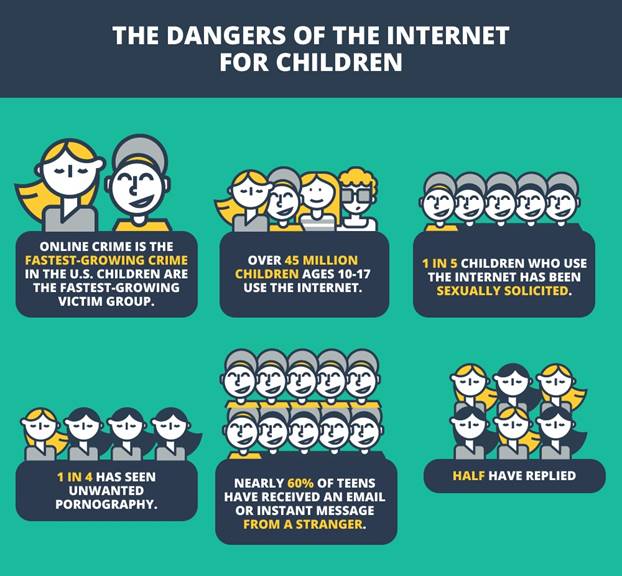Dangers for Children Online
- Filed under "education"
- Published Monday, February 10, 2020
- « back to articles

In our educational activities, we often share the perils the internet poses for children, particularly for girls, as they may easily become victims of online predators and traffickers. To see a brief video about the many ways children and teens might be threatened online, click here.

One in five children who use the internet have been sexually solicited, one in 4 has seen unwanted pornography, and 60% of teens have received email or an instant message from a stranger – half have replied.
Although the internet offers tremendous opportunity, it can also be a very dangerous place. Here are the greatest risks facing children and teens online:
CYBERBULLYING: According to Internetsafety101.org, 90% of teens using social media have ignored bullying they've witnessed, and 1 of 3 have been victims of cyberbullying themselves. The best way to protect children against cyberbullying is to be comfortable talking to your children about what is going on in their lives and how to stand up to bullies.
CYBERPREDATORS: Predators commonly stalk children and teens online – they play on their innocence and trust and can entice them into dangerous personal encounters. Unsupervised chat rooms are some of the most dangerous internet sites for young users. The best defense: monitor their internet use andtalk to your children about what is happening in their lives.
POSTING PRIVATE INFORMATION: Kids aren’t yet familiar with social boundaries and may post personal information online in their profiles. Check what they are posting in public view – if you can see it, so can everyone else. Again, talk to kids about public and private boundaries

PHISHING: This is what cybersecurity pros call the use of email to fool people to clicking on potentially dangerous links or attachments. Malicious text messages (termed “smishing”) can pop up at any time. Cybercriminals watch sites that are popular with children, so teach them to delete emails or texts from strangers or unrecognized addresses or numbers.
SCAMS: Scams focused on kids may offer access to online games or prizes, and can promise them in return for personal information or parents’ credit card information. Teach kids that if it sounds too good to be true, is likely isn’t, so be leery of unsolicited offers.
ACCIDENTAL DOWNLOADS: Malware is software that can automatically install and be harmful to the computer and information stored online. Kids can also be unwittingly lured into pornographic sites. Warning children is best, as is antivirus software or other internet security products such as parental control.
PERSONAL POSTS THAT MAY BE COMPROMISING: Assure that children know that whatever they put online is permanent – it becomes public information and cannot ever be deleted or recalled (even though kids think they are able to do so). Not only can photos or statements be used to bully or harass a child, but a future partner or employer will also have access to whatever has been posted online.
If you’re around kids or families, be sure to learn more about computers and the internet to be able to monitor a child or teen’s usage, and keep home computers in a common area of the house. Look for free parental controls such as Xfinity or Spectrum, and share this information with others…it’s better to be safe than sorry.